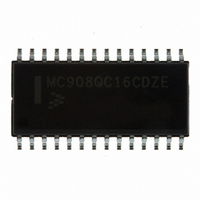MC908QC16CDZE Freescale Semiconductor, MC908QC16CDZE Datasheet - Page 103

MC908QC16CDZE
Manufacturer Part Number
MC908QC16CDZE
Description
IC MCU 8BIT 16K FLASH 28-SOIC
Manufacturer
Freescale Semiconductor
Series
HC08r
Specifications of MC908QC16CDZE
Core Processor
HC08
Core Size
8-Bit
Speed
8MHz
Connectivity
SCI, SPI
Peripherals
LVD, POR, PWM
Number Of I /o
24
Program Memory Size
16KB (16K x 8)
Program Memory Type
FLASH
Ram Size
512 x 8
Voltage - Supply (vcc/vdd)
3 V ~ 5.5 V
Data Converters
A/D 10x10b
Oscillator Type
Internal
Operating Temperature
-40°C ~ 85°C
Package / Case
28-SOIC (7.5mm Width)
Processor Series
HC08QC
Core
HC08
Data Bus Width
8 bit
Data Ram Size
512 B
Interface Type
ESCI/SPI
Maximum Clock Frequency
8 MHz
Number Of Programmable I/os
26
Number Of Timers
6
Maximum Operating Temperature
+ 85 C
Mounting Style
SMD/SMT
Development Tools By Supplier
FSICEBASE, M68CBL05AE, DEMO908QB8, DEMO908QC16
Minimum Operating Temperature
- 40 C
On-chip Adc
10-ch x 10-bit
For Use With
DEMO908QC16 - BOARD DEMO FOR MC908QC16
Lead Free Status / RoHS Status
Lead free / RoHS Compliant
Eeprom Size
-
Lead Free Status / Rohs Status
Lead free / RoHS Compliant
Available stocks
Company
Part Number
Manufacturer
Quantity
Price
Company:
Part Number:
MC908QC16CDZE
Manufacturer:
FREESCALE
Quantity:
1 600
Part Number:
MC908QC16CDZE
Manufacturer:
FREESCALE
Quantity:
20 000
- Current page: 103 of 274
- Download datasheet (4Mb)
To protect status bits during the break state, write a 0 to BCFE. With BCFE cleared (its default state),
software can read and write registers during the break state without affecting status bits. Some status bits
have a two-step read/write clearing procedure. If software does the first step on such a bit before the
break, the bit cannot change during the break state as long as BCFE is cleared. After the break, doing
the second step clears the status bit.
10.7 I/O Signals
The OSC shares its pins with general-purpose input/output (I/O) port pins. See
location of these shared pins.
10.7.1 Oscillator Input Pin (OSC1)
The OSC1 pin is an input to the crystal oscillator amplifier, an input to the RC oscillator circuit, or an input
from an external clock source.
When the OSC is configured for internal oscillator, the OSC1 pin can be used as a general-purpose
input/output (I/O) port pin or other alternative pin function.
10.7.2 Oscillator Output Pin (OSC2)
For the XTAL oscillator option, the OSC2 pin is the output of the crystal oscillator amplifier.
When the OSC is configured for internal oscillator, external clock, or RC, the OSC2 pin can be used as a
general-purpose I/O port pin or other alternative pin function. When the oscillator is configured for internal
or RC, the OSC2 pin can be used to output BUSCLKX4.
10.8 Registers
The oscillator module contains two registers:
10.8.1 Oscillator Status and Control Register
The oscillator status and control register (OSCSC) contains the bits for switching between internal and
external clock sources. If the application uses an external crystal, bits in this register are used to select
the crystal oscillator amplifier necessary for the desired crystal. While running off the internal clock
source, the user can use bits in this register to select the internal clock source frequency.
Freescale Semiconductor
•
•
Oscillator status and control register (OSCSC)
Oscillator trim register (OSCTRIM)
Internal oscillator
XTAL oscillator
External clock
RC oscillator
MC68HC908QC16 • MC68HC908QC8 • MC68HC908QC4 Data Sheet, Rev. 5
Option
or
Inverting OSC1
General-purpose I/O or alternative pin function
Controlled by OSC2EN bit
Table 10-1. OSC2 Pin Function
OSC2EN = 0: General-purpose I/O or alternative pin function
OSC2EN = 1: BUSCLKX4 output
OSC2 Pin Function
Figure 10-1
for port
I/O Signals
103
Related parts for MC908QC16CDZE
Image
Part Number
Description
Manufacturer
Datasheet
Request
R
Part Number:
Description:
Manufacturer:
Freescale Semiconductor, Inc
Datasheet:
Part Number:
Description:
Manufacturer:
Freescale Semiconductor, Inc
Datasheet:
Part Number:
Description:
Manufacturer:
Freescale Semiconductor, Inc
Datasheet:
Part Number:
Description:
Manufacturer:
Freescale Semiconductor, Inc
Datasheet:
Part Number:
Description:
Manufacturer:
Freescale Semiconductor, Inc
Datasheet:
Part Number:
Description:
Manufacturer:
Freescale Semiconductor, Inc
Datasheet:
Part Number:
Description:
Manufacturer:
Freescale Semiconductor, Inc
Datasheet:
Part Number:
Description:
Manufacturer:
Freescale Semiconductor, Inc
Datasheet:
Part Number:
Description:
Manufacturer:
Freescale Semiconductor, Inc
Datasheet:
Part Number:
Description:
Manufacturer:
Freescale Semiconductor, Inc
Datasheet:
Part Number:
Description:
Manufacturer:
Freescale Semiconductor, Inc
Datasheet:
Part Number:
Description:
Manufacturer:
Freescale Semiconductor, Inc
Datasheet:
Part Number:
Description:
Manufacturer:
Freescale Semiconductor, Inc
Datasheet:
Part Number:
Description:
Manufacturer:
Freescale Semiconductor, Inc
Datasheet:
Part Number:
Description:
Manufacturer:
Freescale Semiconductor, Inc
Datasheet:











